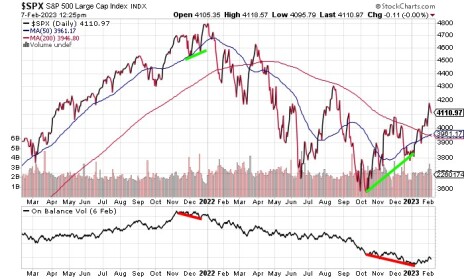There are dozens of different technical indicators and studies that you can apply to a chart when you’re performing technical analysis, including On Balance Volume, which we’ll cover today. No matter how complicated an indicator may seem, the truth is there are only three input variables for any of them: Price, volume and time.
Arguably the most straightforward, and one used frequently by traders, is the simple moving average. That is, the average closing price over x periods, with 50- and 200-day moving averages being the most frequently cited in Cabot advisories. Other periods can be used effectively as well. Cabot Growth Investor, for instance, uses a 35-week moving average for the Cabot Trend Lines.
[text_ad]
More complicated indicators just apply extra math to those input variables to generate different results. Exponential moving averages (EMA) are weighted to assign more value to more recent price data; average true range (ATR) introduces volatility by looking at the difference between high and low prices on a day (or hour, minute, week, etc.) and then averaging those (same inputs, more math); Keltner Channels create a band by wrapping ATR around an EMA. You get the picture.
What is On Balance Volume?
On Balance Volume (OBV) is a momentum indicator that was originally devised by Joseph Granville in his 1963 book New Key to Stock Market Profits, and its beauty lies in its simplicity. Beginning at an arbitrary point in time, you add a security’s volume on up days and subtract a security’s volume on down days.
| Day | Price | Volume | On Balance Volume |
| 1. | $10 | 10,000 | 0 |
| 2. | $10.15 | 15,000 | 15,000 |
| 3. | $10.10 | 8,000 | 7,000 |
| 4. | $10.20 | 13,000 | 20,000 |
In the table above, we start with a price of $10 on day one. Day two closes higher so the volume is added to our running On Balance Volume column. Day three closes lower than the previous day so volume is subtracted, and day four closes higher so volume is added again.
The actual On Balance Volume number is largely irrelevant because the start time is arbitrary. What is useful is measuring the change over time because it signals whether shares are being accumulated.
A stock that is in a strong uptrend should have a rising OBV line while a stock that is down-trending should have a falling OBV line. You can see this on the chart of the S&P 500 below.
The S&P was moving higher for most of 2021 and the rising OBV line matches the trend. By that same token, the S&P was falling most of last year, and we see a falling OBV.
“Great,” I can imagine you saying, “if a stock is going up, I know it’s going up, and if it’s going down, I know it’s going down. What good does this do me?”
Part of the reason the beginning of this post covered input variables is to illustrate a weakness in technical analysis. Technical analysis, as useful as it can be, is not a predictive tool. If all you can base a study on is the price, volume, and time from the past, there’s no way to use it to predict the future.
Where it can be particularly useful, however, is when what a study or indicator is telling you diverges from what the market’s price action seems to be telling you. Divergent signals aren’t limited to On Balance Volume; they’re used with any number of studies.
On the chart above I’ve marked two periods of time, one from mid-November through the end of 2021 and a second from October 2022 to the beginning of 2023.
That first period marks the beginning of the end of the previous bull run. Despite choppy trading to start the month of December, the S&P closed the year at its highs. The green line marks the higher lows at the end of the year (and corresponding higher highs). The red line on the On Balance Volume portion (bottom of the chart) corresponds with the same time period.
Despite the S&P reaching new highs, OBV spent the same time setting lower highs and lower lows. In essence, volume accumulation did not match the rising share prices; the market had become overbought.
Once stocks broke down, OBV and the S&P price chart began making concurrent lower lows and lower highs, confirming the downtrend.
This brings us to the second period. As you can see on the chart, the rally in the S&P 500 to end the year arose with a backdrop of declining OBV. That signals that price appreciation is not being supported by buying volume.
The folks at SentimenTrader track proprietary indicators that are intended to measure the “confidence” of money flows by “smart” (i.e., institutional) traders as well as “dumb” (i.e., retail) traders. As of the latest readings, these indicators are attributing the rally to buying by retail investors, who are showing a high confidence level.
Meanwhile, the “smart” money indicators are at exceedingly depressed levels. Now, OBV has begun to climb a little of late, which points to one of two scenarios: Either retail investors were ahead of institutions in identifying the bottom, and now big buyers are going to be playing catch-up, or this retail rally could be highly sensitive to selling pressure when sentiment changes in the retail segment (if only retail is buying, there’s no bid to catch when they decide to start selling).
Neither scenario inspires much confidence, and investors would be well served to treat this as a yellow caution flag. That means keeping new buys on the smaller side and keeping stops a little tighter than you might otherwise.
As I wrote previously, there are no predictive technical indicators, but Granville was a proponent of the idea that volume is ultimately a leading indicator, and that price inevitably catches up. As we watch this play out, keep an eye open for divergent signals from momentum indicators that may give you an early indication that buying is running out of steam (or, conversely, that big buyers are joining the fray).
Had you used - or heard of - On Balance Volume before? What technical indicators do you use? Tell us about them in the comments below!
[author_ad]
*This post was originally published in 2022 and is periodically updated to reflect market conditions.



